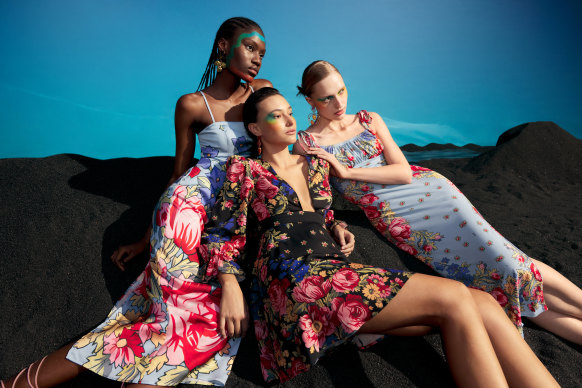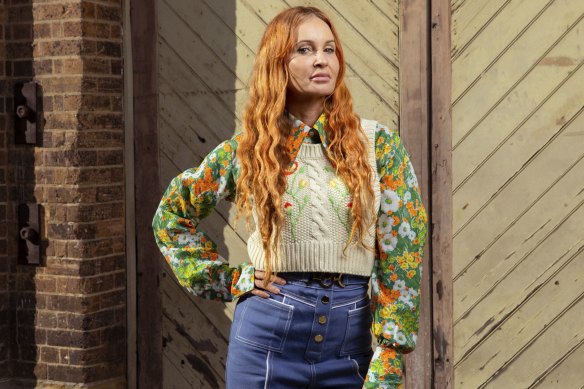This was published 5 months ago
‘I’m not scared of the words fast fashion’: Alice McCall defends Shein collaboration
By Jessica Yun and Lauren Ironmonger
Australian fashion designer Alice McCall has described her new collaboration with ultra-cheap Chinese fashion giant Shein as “very good quality” in comments that have been criticised by sustainability experts and labelled as paradoxical.
The designer’s latest collaboration with Shein – her second with the fast fashion giant – is a 65-piece collection featuring bold patterns and colours, as well as the feminine, whimsical designs McCall is known for. Prices start at $8 for a mesh dress. The most expensive item is a pair of PU leather pants for $38.
At a launch event in Sydney on Thursday, McCall lauded the quality of the products and said she “absolutely would” call the products “investment” pieces.

Australian designer Alice McCall has launched her second collaboration with fast fashion retailer Shein.
“In today’s economic climate, to be able to create an Alice piece because of Shein and their platform and then giving a customer the opportunity to invest in a piece [who] might not be able to afford it otherwise, is something that I’m really happy about and really proud of,” she told this masthead.
“You can have longevity within the wardrobe. All of the patterns, the silhouettes, the cuts, they’re really, really good. I’ve worked with the right fabrics for the right cut, so there’s durability in the garment. Absolutely you can have these pieces in your wardrobe for five, 10 years.”
McCall closed the doors to her namesake brand in February 2023, 19 years after she founded it and two years after the company went into voluntary administration. In November, she attracted criticism for her collaboration with the Chinese retailer, which has been accused of using forced labor practices, of dodging import taxes and of being opaque about its supply chain.
Shein’s annual sustainability report, released yesterday, revealed the company discovered two cases of suppliers using child labour in 2023.
The designer, who on Thursday described the Shein team as “family”, has defended her partnership with the company.

Designer Alice McCall has defended her partnership with Shein.Credit: Dominic Lorrimer
“Fast fashion doesn’t need to mean disposable fashion. It can just mean available fashion,” she said.
“To have these garments available internationally at that price at a very good quality, I’m not scared of the words ‘fast fashion’, you know? And neither is the world, hence why Shein’s been so successful.”
But Clare Press, a sustainability advocate and the author of Wear Next: Fashioning The Future, is wary of characterisations of fast fashion as investment pieces.
“That’s an oxymoron. The whole idea of fast fashion is rapid turnover, both in terms of trends, and of the physical garments, which often literally fall apart at the seams after a few wears. That doesn’t mean people can’t – or don’t – keep wearing their more robust fast fashion buys for longer.
“But if we’re talking about a brand trying to argue that a fast fashion piece is actually designed to be a high-quality investment piece, that’s disingenuous. Their business model is built on churning out garments as cheaply as possible. These garments are not designed to last, except once they become waste [most fast fashion is made from synthetic material that does not break down].”
While McCall’s first collaboration with Shein incorporated recycled textiles sourced by tech platform Queen of Raw, this new collection is made almost entirely from the new synthetics prevalent in most fast fashion.
McCall described her work with the recycled textiles platform as “a really great experience” but she said repurposed fabrics could be very expensive.
“My answer to sustainability is to design something that you can keep in your wardrobe.”
Shein says it has a commitment to ethical and sustainable practices, but the company has previously been accused of greenwashing, including through donations to NGOs and via influencer junkets.
McCall is not the first designer to partner with a fast fashion retailer in the name of accessibility for the masses. Scandinavian retailer H&M has become known for its high fashion collaborations with big names like Karl Lagerfeld and Versace that sell out almost instantly.
But today’s collaborations are a different beast, as the gap between traditional fast fashion retailers like Zara and ultra-fast newcomers like Shein grows.
“Brands like Shein and Temu are a totally new phenomenon for the digital age,” says Press.
“I remember when we thought Topshop was speedy because they could get designs into the shops in a couple of weeks. That now seems incredibly slow and old-fashioned.”
The collaboration is Shein’s first with an Australian designer as part of a program called Shein X that partners with 4600 collaborators globally including artists, designers and creatives.
Founder of Eco Styles and circular economy and waste program director at The Australia Institute, Nina Gbor, is concerned about what the partnership means for Australian fashion.
“While it’s great that Alice McCall has done something around inclusivity and accessibility, this partnership legitimises Shein in the Australian market, and also globally considering she is a luxury label.”
“The problem is we’ve had so many Australian brands close down because they can’t compete with companies like Shein.”
While Shein X purports to champion designers, Press says an “important distinction” of the company “is their lack of design”.
“Despite their proliferation and the outsized media attention, designer collabs are not their main game. 99 per cent of what these behemoths do is use AI to scrape the internet for inspiration in order to churn out a hotchpotch of random product based on what’s trending on TikTok.”
Around 2 million Australians shop with Shein, according to recent Roy Morgan data and 42 per cent of Shein shoppers made more than two orders with the Chinese giant in the 12 months to June. Most Shein shoppers are women (78 per cent). The biggest demographic is aged 35 to 49 (28 per cent), followed by 25 to 34-year-olds (24 per cent). Shein is predicted to hit and possibly surpass $1.3 billion in sales.
Make the most of your health, relationships, fitness and nutrition with our Live Well newsletter. Get it in your inbox every Monday.